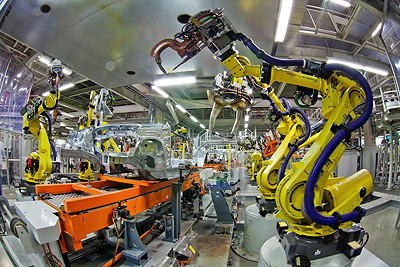The UK’s robotics lag could worsen after Brexit

The UK’s departure from the European Union could have a further detrimental effect on the uptake of industrial robots in the UK, according to a new report from the Centre for Economic and Business Research (Cebr) and Redwood Software. The report also suggests that investment in robotics offers better long-term value-for-money than investments in financial services, property or transport.
“Given the tough political climate, there are certainly interesting times ahead for the robotics market in the UK,” says the Cebr’s managing director, David Whitaker. “Growth and modernisation in the automotive industry has been a key driver of UK robotics growth in recent years. As a result, continued growth in the UK robotics market will depend heavily on whether planned investments in this industry do indeed progress following Brexit, as this will stimulate many robot unit purchasing decisions.”
The report points out that the UK already lags behind the US, Germany, Japan and South Korea in robotics investments and robot densities. There are only 33 robots per 10,000 employees in general industry in the UK, and the number of new industrial robots installed during 2015 was 21% down on 2014.
By contrast, robotics investment in the US has almost tripled since 2009 and was worth $86bn in 2015 – about 62 times more than the UK, when expressed in 2015 PPP (purchasing power parity) terms.
The UK’s robot density in 2015 was only 10 robots for every million hours worked, compared to 131 in the US, 167 in Japan and 133 in Germany. According to the report, there is a positive association between robotics density and labour productivity.
“The UK clearly has a lot to learn from other regions to bolster its robotics market,” says Neil Kinson, chief of staff at Redwood Software. “The US, for example, is a shining example of an industrial sector that is leading the world in its use of robotics right across operations.
“Robotics and automation in manufacturing has been a contentious topic in the last 12 months,” he adds, “but the research shows that the sector is one of the best places to invest today, and the returns are likely to improve as time goes on. Even in such uncertain times in the post-Brexit economy, the UK government must do more in collaboration with businesses and industry to bolster such investment.”
Worldwide, investment in robotics reached an 18-year peak in 2015. While robotics remains a relatively small part of global economies, the report finds that it has made a significant contribution to worldwide GDP growth – accounting for as much as 10% of total growth over the past 22 years. Results from Cebr’s baseline econometric model show that a 1% increase in robotics investment is associated with a long-run increase in GDP per capita of 0.03.

The report also suggests that investment in robotics has a greater positive impact on the economy than more established sectors such as information technology, construction and real estate – even though these sectors benefit from economies of scale that robotics cannot match.
“There is no doubt about it – robotics is now a significant contributor to economic growth,” says Whitaker. “Robotics’ cumulative impact on the overall economy has been much larger compared to the monetary value of robotics today.”
“The pace of robotic automation has accelerated in recent years,” Kinson adds. “The new frontier will be the automation of mundane back-office tasks, and an approach that focuses on maximum efficiency for the task at hand, rather than simply swapping human effort for machine effort.’
The study does not address directly the effects of robots on employment, but says that evidence indicates that robotic automation is a positive for employment.
“There is clear evidence that points towards robotic automation in many cases being a complement for human labour, rather than a direct substitute,” says Whitaker. “As more mundane tasks are automated, human effort becomes more valuable as it is focused on higher-level tasks, creativity, know-how and thinking.”
“Robotic automation is increasing the total number of jobs available – but it is also changing them,” Kinson adds. “The increased level of automation investment highlights the need to rethink how we approach the skill-sets needed in the workplace, and the importance of working with automation, and not against it.”
This study examines the impact of robotics automation on economic development across OECD countries including the UK and the US. It considers trends in robotics automation in 23 countries from 1993 to 2015, before applying a growth accounting framework and econometric analysis to quantify the impact of robotics on two key macroeconomic indicators: GDP per capita and labour productivity.





